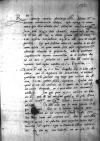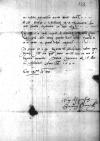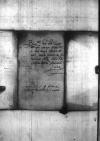Sacra ⌊maiestas regia⌋, dominus clementissimus, imposuit mihi hoc negotii, ut suae maiestatis litteras in aulam ⌊caesareae maiestatis⌋ ad manus Dominationis Vestrae Reverendissimae ocissime transmitterem inque ea re nulli operae et sumptui parcerem. Ego, quod debitum meum est, quantum in me fuit, curavi sedulo, ut quam maxime fieri possit, compendiosis et celerrimis itineribus eo perferrentur, nullis id quantumvis sumptuosioribus impensis remorantibus, ita ut confidam illas sat cito Reverendissimae Dominationi Vestrae perlatum iri, quas ⌊illius maiestati⌋ reddere ac responsum haud segnius remittere Reverendissima Dominatio Vestra dignabitur.
Redditae sunt mihi Reverendissimae Dominationis Vestrae litterae ⌊Bruxellis⌋ missae de data a die(?) 2 Octobris, quae ob singularem eius humanitatem, ut debebant, gratissimae mihi fuerunt eoque magis, quod scribendi hoc officium Dominationi Vestrae Reverendissimae gratum fuisse cognoverim. Equidem dabo operam, ut iam non scribendo, sed, si quando haec se mihi offerat occasio, obsequendo, me si quem alium eius observantissimum intelligat.
Iam quid prius Reverendissimae Dominationi Vestrae scriberem, non habeo, nisi hoc, quod illi omnino antiquissimum gratissimumque esse puto. ⌊Principes nostri⌋ sacratissimi cum serenissimis liberis prospera fruuntur valetudine.
In aliis rebus, quae hic novae habentur, est hic paene [...] paper damaged⌈[...][...] paper damaged⌉vum. Post eas de ⌊palatino Valachiae⌋ partas victorias paper damaged⌈[as]as paper damaged⌉, fuere hic duo ⌊imperatoris Thurcorum⌋ legati, duo item regis ⌊Ioannis⌋ nomine etiamnum sunt, illud omnes apud ⌊maiestatem regiam⌋ agentes, ut palatino pacis perpetuae foedera impetrarentur et captivi, signa ac tormenta bellica restituerentur. Atque haec agi homo insolentissimus, non suo quidem, sed illo AAWO, AB, D. 67, f. 122vrum nomine subornavit, ne se bello fractum, omnibus viribus exhausum summeque pacis egentem indicaret. Nunc rogatu illorum ipsorum concessae illi indutiae et arma suspensa sunt usque ad Kalendas Maias, ob id maxime, quo interea de pacis et foederis iciendi condicionibus accipiend(is) consilium caperet, quae illi praescriptae a ⌊maiestate sacra regia⌋ missae sunt. Ceterum, quod si eas condiciones acceperit et foedus cum illo percutiendum erit, certe haud illius tantum, qui semel fidem prodidit, nisi etiam aliorum et praesertim ⌊regis Ioannis⌋ fide icietur.
AAWO, AB, D. 67, f. 122vrum nomine subornavit, ne se bello fractum, omnibus viribus exhausum summeque pacis egentem indicaret. Nunc rogatu illorum ipsorum concessae illi indutiae et arma suspensa sunt usque ad Kalendas Maias, ob id maxime, quo interea de pacis et foederis iciendi condicionibus accipiend(is) consilium caperet, quae illi praescriptae a ⌊maiestate sacra regia⌋ missae sunt. Ceterum, quod si eas condiciones acceperit et foedus cum illo percutiendum erit, certe haud illius tantum, qui semel fidem prodidit, nisi etiam aliorum et praesertim ⌊regis Ioannis⌋ fide icietur.
De conventione ⌊Patavii⌋ propter tractatus concordiae de regno ⌊Ungariae⌋ destinata, deinde ex parte ⌊regis Ioannis⌋ infecta, Dominationi Vestrae Reverendissimae latere non dubito. Dominus ⌊Hieronimus Lasski⌋, ex ⌊Germania⌋ huc reversus, has maxime eius rei causas dicebat. Primum, quod litterae caesareae ac serenissimi ⌊domini Romanorum regis⌋ ⌊maiestatis⌋ serius, quam debuerant hidden by binding⌈[nt]nt hidden by binding⌉, nempe post Epiphaniam Domini, diem scilicet conventioni destinatum, sibi essent redditae, deinde quod salvus conductus tantum a serenissimo domino ⌊Romanorum rege⌋ et non item a ⌊caesarea maiestate⌋ datus fuerit, praeterea hidden by binding⌈[ea]ea hidden by binding⌉ indutiarum terminum iam iam appetere, postremo excludi ⌊regem suum⌋ indutiarum termino ingruente commoditate et copia temporis, qua commissarios, viros graves, ablegare posset, maxime, cum ⌊neutram maiestatem⌋ illic affuturam intelligeret. Pollicitus tamen est, si huc ad ⌊maiestatem paper damaged⌈[maiestatem]maiestatem paper damaged⌉ sacram regiam⌋ ab illarum maiestatibus his de rebus mitteretur, a ⌊rege suo⌋ quoque missum iri etc.
In ⌊Ungaria⌋ acta sunt proxime comitia, more patriae ⌊Rakosch⌋ dicta. Ceterum, quia his non omnes interfuerant, agentur iterum. In utrisque, quid vel iam tractatum, vel tractandum sit, Dominatio Vestra Reverendissima
 AAWO, AB, D. 67, f. 123r
ex scheda praesentibus inserta abunde discet.
AAWO, AB, D. 67, f. 123r
ex scheda praesentibus inserta abunde discet.
Magnificus dominus ⌊Nicolaus a Schidlovietz⌋ ⌊regni Poloniae⌋ thesaurarius heri vita functus, desiderium sui nobis reliquit.
Quae Reverendissima Dominatio Vestra mihi scripsit de revocando se ex aula ⌊caesaris⌋, egi apud ⌊maiestates utrasque⌋, quantum licuit, sedulo, quarum de ea re animos ex ipsarum litteris cognoscet.
In praesens Dominationem Vestram Reverendissimam longaevam et felicissimam valere cupio precorque, et eius gratioso favori me et servitia mea diligenter commendo.
 AAWO, AB, D. 67, f. 122vrum nomine subornavit, ne se bello fractum, omnibus viribus exhausum summeque pacis egentem indicaret. Nunc rogatu illorum ipsorum concessae illi indutiae et arma suspensa sunt usque ad Kalendas Maias, ob id maxime, quo interea de pacis et foederis iciendi condicionibus accipiend(is) consilium caperet, quae illi praescriptae a
AAWO, AB, D. 67, f. 122vrum nomine subornavit, ne se bello fractum, omnibus viribus exhausum summeque pacis egentem indicaret. Nunc rogatu illorum ipsorum concessae illi indutiae et arma suspensa sunt usque ad Kalendas Maias, ob id maxime, quo interea de pacis et foederis iciendi condicionibus accipiend(is) consilium caperet, quae illi praescriptae a  AAWO, AB, D. 67, f. 123r
ex scheda praesentibus inserta abunde discet.
AAWO, AB, D. 67, f. 123r
ex scheda praesentibus inserta abunde discet.



